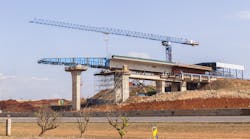I have been doing a little research lately and came across the U.S. Department of Treasury 2020 Transportation Statistics Annual Report, and boy is it chock-full of information.
For example, did you know that Interstate highways make up 1.5% of overall roadways, but handle 25% of the vehicle miles driven?
Or this: Congestion has increased on the nation’s urban freeways and arterial streets 15% over the 2010–2017 period. Congestion cost urban Americans an extra 8.8 billion hours and an extra 3.3 billion gallons of fuel to travel, for a total congestion cost of $166 billion in 2017.
Since 2010 physical growth of the U.S. highway system infrastructure has slowed. Highway mileage, lane miles, and the number of bridges have grown by less than one-half percent per year.
In 2018 the nation’s transportation system moved about 51.0 million tons of goods worth $51.8 billion each day, or about 56.9 tons of freight per capita.
Trucks carried 60.8% of the weight and 60.9% of the value of all goods shipped in the United States in 2018 and continue to be the primary mode for transporting goods less than 1,000 miles.
And finally: Transportation accounted for 9.4% of the gross domestic product in 2018.
So, what’s the point of sharing all of these facts with you?
First, rarely do we see all these statistics about trucking in one place and together they show both the value of trucking to the national economy and the impediments that prevent trucking from being as efficient as it can be.
This of course brings me again to talk about the infrastructure and the need to improve it. However, in reading this report it occurred to me that when we are having discussions about the infrastructure, we need to make absolutely sure how we define the term. “Infrastructure” goes far beyond highways, roads, and bridges. It includes airports, rail, and even the 5G network.
All of those things are important, but as we lobby for the much-needed infrastructure improvements, let’s make sure that we make it crystal clear that we are talking about the things that need to be done to make our highways, roads, and bridges better. In other words, we need to change the fact that, according to the American Society of Civil Engineers, 43% of our public roadways are in poor or mediocre condition.
We need our highways and byways to be improved to enhance efficiency today. And future technologies, like autonomous trucking and platooning, cannot occur without some serious upgrades.
Continue to beat the drum for funding for infrastructure improvements. Just make sure everyone understands which part of the infrastructure you think deserves to be improved first.
Patrick Gaskins, senior vice president of Corcentric Fleet Solutions, oversees both sales and operations for Corcentric’s fleet offerings. Over the past 10 years, Gaskins has grown the fleet services area of Corcentric’s business by implementing a best-in-class asset management database and a data-driven approach to providing Corcentric clients with visibility into all areas of their fleet spend. He joined Corcentric in 2010, bringing over 30 years of experience as a financial services professional in the transportation industry. Gaskins leads a team of industry experts who work with a supply base of over 160 manufacturers to help the country’s largest fleets manage all aspects of their fleet operations and fleet related spend.
Gakins earned his BBA in Finance from the University of Miami, FL, and his CTP certification from the National Private Truck Council.




